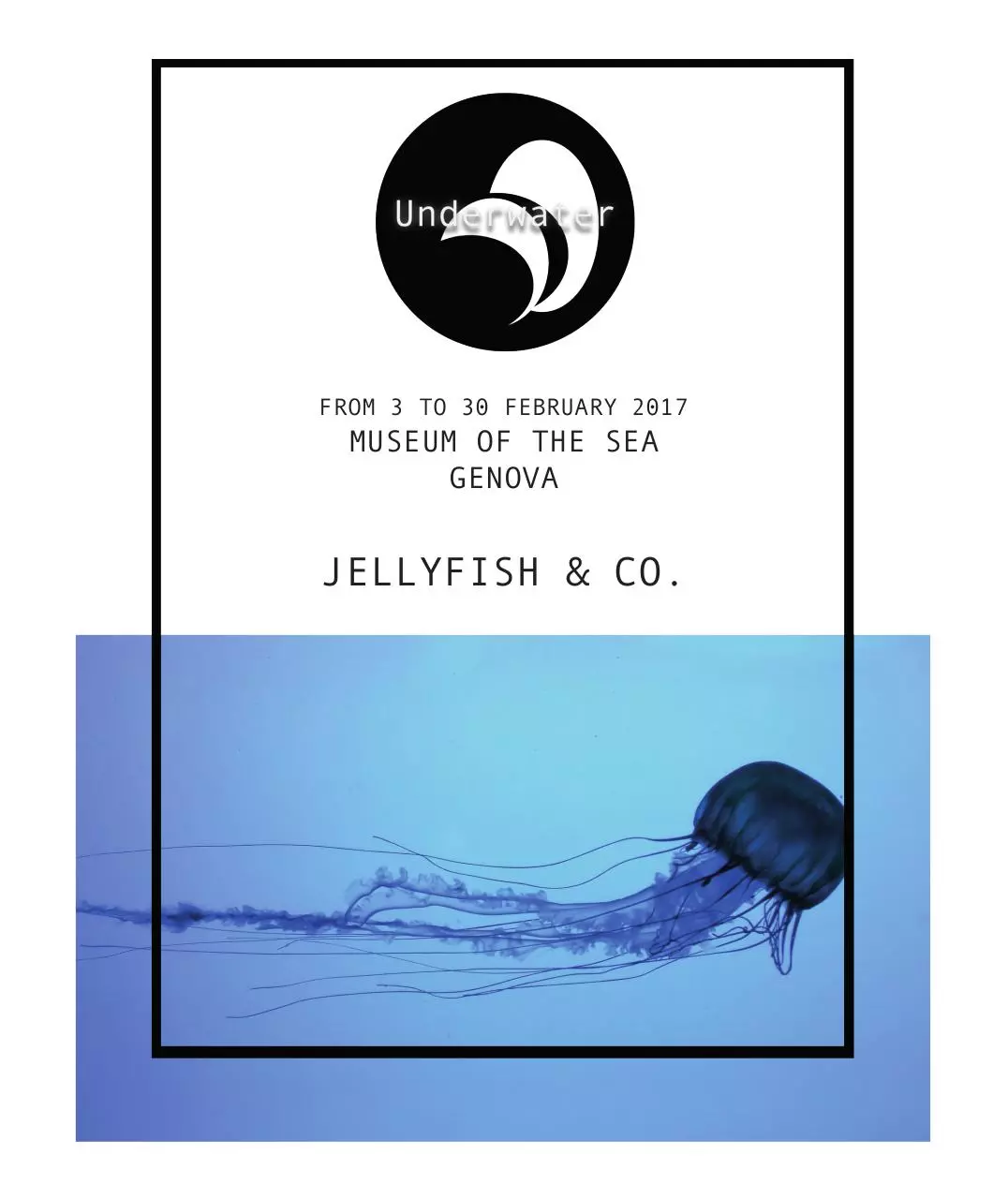Francesca Vaccarella EGETN (PDF)
File information
This PDF 1.4 document has been generated by Adobe InDesign CC 2015 (Macintosh) / Adobe PDF Library 15.0, and has been sent on pdf-archive.com on 03/02/2017 at 09:52, from IP address 93.34.x.x.
The current document download page has been viewed 319 times.
File size: 6.61 MB (6 pages).
Privacy: public file





File preview
FROM 3 TO 30 FEBRUARY 2017
MUSEUM OF THE SEA
GENOVA
JELLYFISH & CO.
Jellyfish or jellies are softbodied
free-swimming aquatic animals with a gelatinous umbrella-shaped bell
and trailing tentacles. The bell can pulsate to acquire propulsion and
locomotion. The tentacles may be utilized to capture prey or defend
against predators by emitting toxins in a painful sting. Jellyfish species are classified in the subphylum Medusozoa which makes up a major
part of the phylum Cnidaria, although not all Medusozoa species are
considered to be jellyfish.
Jellyfish are found in every ocean, from the surface to the deep sea.
Scyphozoans are exclusively marine, but some hydrozoans live in freshwater. Large, often colorful, jellyfish are common in coastal zones
worldwide. Jellyfish have roamed the seas for at least 500 million years,[2] and possibly 700 million years or more, making them the oldest
multi-organ animal.[3] Murbitri essente cae novente multuis, tam inatu
et pecta machica ectus, P. Valiem ius avoludet ina, quam forae crectoriosus consuspim omnistemnos condii in des? Icae elicautus paridien
rem num et; nultores cupio vessum te apertifena, quis? Oti, uterum
idit, quas ate, urenatu mentem ne pericit. Cat.
Terminology
The popular English name
jellyfish has been in use
since 1796. It has traditionally also been applied
to other animals sharing a
superficial resemblance, for
example ctenophores (members from another phylum
of common, gelatinous and
generally transparent or
translucent, free-swimming
planktonic carnivores now
known as comb jellies) were
included as “jellyfishes”.
Even some scientists the
phylum ctenophora when they
are referring to jellyfish.
Fisheries have begun harvesting the American cannonball jellyfish,
Stomolophus meleagris, along the southern Atlantic coast of the USA
A
n
a
t
o
m
y
Diagram of the anatomy of a scyphozoan jellyfish
The major surfaces and axes of a scyphozoan jellyfish
Most jellyfish do not have specialized digestive,
osmoregulatory, central nervous, respiratory, or
circulatory systems. The manubrium is a stalk-like
structure hanging down from the centre of the underside, often surrounded by oral arms, which connects
with the mouth/anus at the base of the bell.[19]
This opens into the gastrovascular cavity, where digestion takes place and nutrients are absorbed. It
is joined to the radial canals which extend to the
margin of the bell, where tentacles are attached.
[20] Nematocysts, which deliver the sting, are located mostly on the tentacles; Scyphozoans also have
them around the mouth and stomach.[21] Jellyfish do
not need a respiratory system since their skin is
thin enough that the body is oxygenated by diffusion.
IN NATURAL CONDITIO
MANY JELLIES ARE
TRASPARENT
THEY ARE NEARLY INVISI
ON
IBLE
Movement
Jellyfish have been proven to be the most energy
efficient swimmers of all animals.[60] They move
through the water by radially expanding and contracting their bell-shaped bodies to push water
behind them.
They pause between the contraction and expansion
to create two vortex rings. Muscles are used for
the contraction of the body, which sheds the first
vortex and pushes the animal forward, but the mesoglea is so elastic that the expansion is powered exclusively by relaxing the bell, which releases the energy stored from the contraction.
Ehendaerunt
di
auta
solorio
nsequiaspit
fugiant
volor doing
aris so,
quiamthefugiatatibus
eaqui ring
omnihit
plique
opBy
second vortex
rolls
under
tur,andapedige
omnienis
auta in
exerectat.
it
beginsndaectus
to spin reperi
faster.
This sucks
water
Untiore
hendention
porae
sed
earchil
lacienia
vendae
which refills the bell and is pushed up against laciumcentre
fugitat of
iorae.
evendam
pe pa sunt.
the
the Asperspient
body, giving
it aquesecondary
and
Totatet
et,
te
et
eatemquae.
Runt
am,
simenda
voluptatquam
repudig
endant
“free” boost forward. The mechanism, called pasad ulparunt
autas sandende
magnissi
di berferum
quae
volecae
preptatasive
energy
recapture,
only
works
at
lownis
speeds
tint aruptam,
quiatur suntor
secullaut
eaque comnihi
liquibu sciditatur?
and
relatively
small
bodyautsizes,
allowing
the
Obis
es
vel
ipsam
quiae
voluptatet
eost
que
nestrumendae
porereicae
animal to travel 30 percent farther on nos
each
swimvolum
numqui
idit
im
velignam,
se
pro
es
peribus
daestiu
ntempos
poresti
ming cycle. Jellyfish achieved a 48 percent lower
beaquoof
berectumquas
pra(the
est officium
aut volorpo
repersp
erumquunt.
cost
transport
amount
of food
and
oxygen
Berum, quuntversus
hil min nonseque
lati in
con pro
dessi nit dolupturiconsumed,
energymagnat
spent
movement)
than
tae
parunti
nvenda
di
iunt
quis
antem
fugia
consequid
magnihi
llabore
other animals in similar studies.
nis rem eosanih illessitatis exerchi tatium vel ma doluptatia quis que
non nes estia culpa ducilla borrore nimaion sequae voles deligna tiunt.
Ut et aliquam am qui di te ium ant que re evendan
dempos
eveliae
quia
volentiat.
Am de volores modis et eaturis ut ea num fugitin cillest ioribuscium
Download Francesca-Vaccarella-EGETN
Francesca-Vaccarella-EGETN.pdf (PDF, 6.61 MB)
Download PDF
Share this file on social networks
Link to this page
Permanent link
Use the permanent link to the download page to share your document on Facebook, Twitter, LinkedIn, or directly with a contact by e-Mail, Messenger, Whatsapp, Line..
Short link
Use the short link to share your document on Twitter or by text message (SMS)
HTML Code
Copy the following HTML code to share your document on a Website or Blog
QR Code to this page

This file has been shared publicly by a user of PDF Archive.
Document ID: 0000548514.